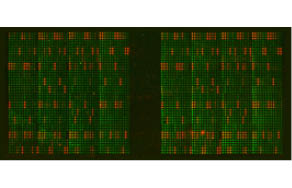
Recently, I issued a post about a method which allows measuring microtuble binding capabilities of proteins of interest. Today, I invite you to look at methods for measuring the dynamic polymerisation of tubulin to microtubules and to detect the impact of compounds or other variables in your experiments on this process.

Tubulin represents one of the major cytoskeleton structures. It plays an important role in cell structure, intracellular transport, and mitosis. In eukaryotic cells, tubulin polymerizes to form structures called microtubules (MTs) (Fig. 1). When tubulin polymerizes it initially forms proto-filaments, MTs consist of 13 protofilaments and are 25nm in diameter, each um of MT length is composed of 1650 heterodimers. Microtubules are highly ordered fibers that have an intrinsic polarity, shown schematically in Figure 2. Tubulin can polymerize from both ends in vitro, however, the rate of polymerization is not equal. It has therefore become the convention to call the rapidly polymerizing end the plus-end of a microtubule and the slowly polymerizing end the minus-end. In vivo, the plus end of a microtubule is distal to the microtubule organizing center.
Different formats of tubulin polymerisation assays
Cytoskeleton Inc. has developed and commercialized a set of tubulin polymerisation assays which are adapted to different experimental set ups and questions. If you’re interested in measuring tubulin polymerisation and/or the effects of specific compounds on tubulin polymerisation, you’ll surely find the assay best suited to your model.
Absorbance and fluorescence formats

There are two types of tubulin polymerization assay, these are the absorbance and fluorescence formats.
The optical density based tubulin polymerization assay (027BK004P) is highly referenced in scientific literature. This assay is based on an adaptation of the original method of Shelanski et al. and Lee et al. (1, 2), which demonstrated that light is scattered by microtubules to an extent that is proportional to the concentration of microtubule polymer. The resulting polymerization curve is representative of the three phases of microtubule polymerization, namely nucleation, growth and steady state equilibrium (Fig 3). While the tubulin polymerisation kit 027BK004P contains tubulin with a purity of 97%, tubulin polymerisation kit 027BK006P – an optical density based assay as well – contains highly purified tubulin with a purity of >99%. This assay is a good secondary screen for determining IC50s.

In most cases, the fluorescence format is recommended because the assay is highly sensitive and economical. The fluorescence tubulin polymerization assay (027BK011P) is an economical one-step procedure for determining the effects of drugs or proteins on tubulin polymerization. It’s an adaptation of an assay originally described by Bonne, D. et al. (3). Polymerization is followed by fluorescence enhancement due to the incorporation of a fluorescent reporter into microtubules as polymerization occurs. The standard assay uses neuronal tubulin (027T240) which generates a polymerization curve representing the three phases of microtubule formation, namely nucleation (Phase I in Figure 4), growth (Phase II in Figure 4) and steady state equilibrium (Phase III in Figure 4).
Measuring tubulin polymerisation with other types of tubulin
For more selective anti-cancer drug development, a very exciting secondary screen can be achieved using Cancer Cell Line Tubulin. Currently, HeLa and MCF-7 cell line tubulins can be used in the fluorescence polymerization assay (027H001 and 027H005, respectively). It has been shown that anti-cancer drugs have different affinities for these tubulins compared to porcine brain (neuronal) tubulin. This indicates that a drug development program aimed at increasing the affinity for cancer cell line tubulin over neuronal tubulin may lead to greater targeting efficiency toward cancer cells.
Cytoskeleton Inc. (available in Europe through tebu-bio), also offers other tubulins, such as fungal tubulins, plant tubulins, or bacterial tubulin analogs which can also be used in tubulin polymerisation assays.
Interested in our tubulin polymerisation kits? Contact me through the form below.
Thank you to our friends at Cytoskeleton Inc. who provided the material used for this post.
References
- Shelanski, M. L., Gaskin, F. and Cantor, C. R. (1973). Microtubule assembly in the absence of added nucleotides. Proc. Natl. Acad. Sci. U.S.A. 70, 765-768.
- Lee, J. C. and Timasheff, S. N. (1977). In vitro reconstitution of calf brain microtubules: effects of solution variable. Biochemistry, 16, 1754-1762.
- Bonne, D., Heusele, C., Simon, C., and Pantaloni, D. (1985). 4’, 6-Diamidino-2-phenylindole, a fluorescent probe for tubulin and mictrotubules. J. Biol. Chem. 260, 2819-2825.



